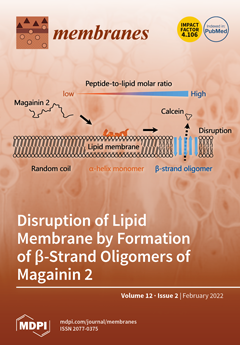The recent expansion of global Lithium Ion Battery (LIBs) production has generated a significant stress on the lithium demand. One of the means to produce this element is its extraction from different aqueous sources (salars, geothermal water etc.). However, the presence of other
[...] Read more.
The recent expansion of global Lithium Ion Battery (LIBs) production has generated a significant stress on the lithium demand. One of the means to produce this element is its extraction from different aqueous sources (salars, geothermal water etc.). However, the presence of other mono- and divalent cations makes this extraction relatively complex. Herein, we propose lithium-sodium separation by an electrodialysis (ED) process using a Lithium Composite Membrane (LCM), whose effectiveness was previously demonstrated by a Diffusion Dialysis process (previous work). LCM performances in terms of lithium Recovery Ratio (RR(Li
+)) and Selectivity (S(Li/Na)) were investigated using different Li
+/Na
+ reconstituted solutions and two ED cells: a two-compartment cell was chosen for its simplicity, and a four-compartment one was selected for its potential to isolate the redox reactions at the electrodes. We demonstrated that the four-compartment cell use was advantageous since it provided membrane protection from protons and gases generated by the electrodes but that membrane selectivity was negatively affected. The impact of the applied current density and the concentration ratio of Na
+ and Li
+ in the feed compartment ([Na
+]
F/[Li
+]
F) were tested using the four-compartment cell. We showed that increasing the current density led to an improvement of RR(Li
+) but to a reduction in the LCM selectivity towards Li
+. Increasing the [Na
+]
F/[Li
+]
F ratios to 10 had a positive effect on the membrane performance. However, for high values of this ratio, both RR(Li
+) and S(Li/Na) decreased. The optimal results were obtained at [Na
+]
F/[Li
+]
F near 10, where we succeeded in extracting more than 10% of the initial Li
+ concentration with a selectivity value around 112 after 4 h of ED experiment at 0.5 mA·cm
−2. Thus, we can objectively estimate that the concept of this selective extraction of Li
+ from a mixture even when concentrated in Na
+ using an ED process was validated.
Full article






